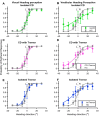Exploring Heading Direction Perception in Cervical Dystonia, Tremor, and Their Coexistence
- PMID: 38539606
- PMCID: PMC10968854
- DOI: 10.3390/brainsci14030217
Exploring Heading Direction Perception in Cervical Dystonia, Tremor, and Their Coexistence
Abstract
Objective: Dystonias, characterized by excessive muscle contractions resulting in involuntary postures and movements, impact 3 million people globally, making them the third most common movement disorder. Often accompanied by tremors, dystonias have epidemiological links and non-motor features shared with isolated tremor, such as essential tremor. Both dystonia and tremor present with balance dysfunction and abnormal involuntary movements, potentially linked to abnormal cerebellar function. This study explores the perception of one's own linear movement, heading, particularly discrimination of heading direction, in isolated cervical dystonia, isolated tremor, and their combination. We compare such perception behavior in visual and vestibular domains, predicting that visual heading perception would be superior to vestibular heading perception.
Methods: Following the focus on the perception of heading direction, we used psychophysics techniques, such as two-alternative-forced-choice task, to examine perception of direction of one's own movements as they see isolated visual star-cloud movement (visual heading perception) and en bloc body movement (vestibular heading perception). We fitted a sigmoidal psychometric function curve to determine the threshold for visual or vestibular heading perception in our participants.
Results: Nineteen participants underwent a two-alternative forced-choice task in the vestibular and visual domains. Results reveal elevated vestibular heading perception thresholds in cervical dystonia with or without tremor, and isolated tremor compared to healthy controls. Vestibular heading perception threshold was comparable in cervical dystonia with tremor and isolated tremor, but it was even worse in isolated cervical dystonia. Visual heading perception, however, remained less affected all three conditions-isolated cervical dystonia, isolated tremor, and their combination.
Conclusion: These findings indicate shared deficits and distinctions in the perception of linear translational heading across movement disorders, such as isolated cervical dystonia, tremor, or their combination, offering insights into their pathophysiology, particularly the involvement of cerebellum regions responsible for vestibular processing.
Keywords: balance; basal ganglia; cerebellum; dystonia; dystonic tremor; postural abnormality; tremor; tremor associated with dystonia.
Conflict of interest statement
The authors declare no conflicts of interest.
Figures



References
LinkOut - more resources
Full Text Sources
Research Materials

